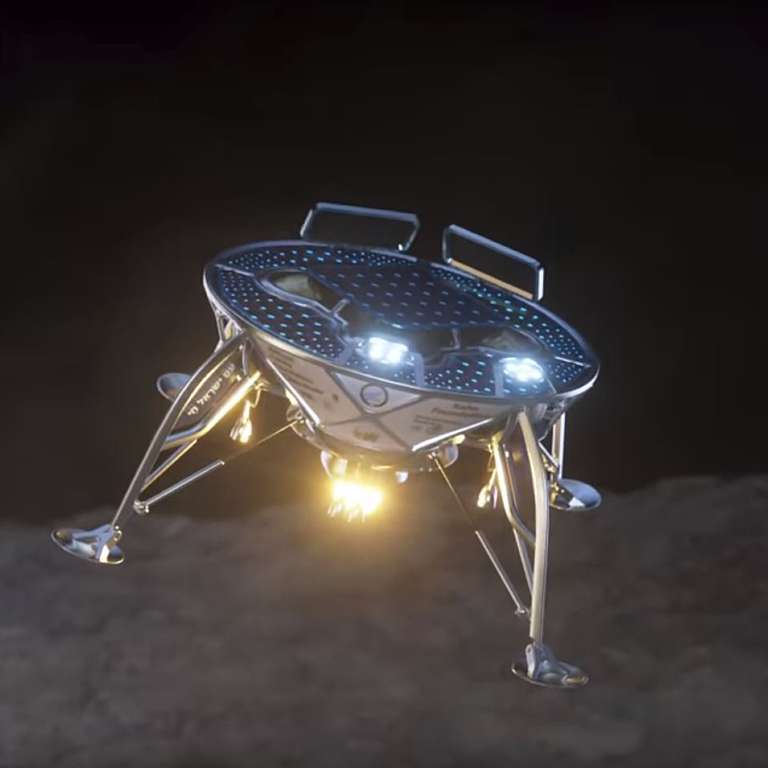Jason Davis • Apr 17, 2019
Software Command to Fix Faulty Sensor Doomed Beresheet
Six days after SpaceIL's Beresheet spacecraft crash-landed on the lunar surface, we now have an explanation for what went wrong: A software command uploaded to fix a sensor problem started a chain reaction that shut down the main engines, dooming the lander.
NASA's Lunar Reconnaissance Orbiter will have an opportunity to image the crash site in the next couple weeks, which is good news for a NASA-provided retroreflector and microscopic lunar library that may have survived the crash.
Beresheet1, a private Israeli Moon mission
Beresheet1 was a private Moon lander by Israeli non-profit SpaceIL that crashed on the surface in 2019.
News Brief
On an episode of Planetary Radio released today, SpaceIL engineer Yoav Landsman said the first few minutes of Beresheet's descent perfectly mirrored simulations. The first sign of trouble began when one of the spacecraft's Inertial Measurement Units, which provide velocity vector and acceleration data, suddenly shut down. The reason for the failure is still unknown.
According to a report by The Jerusalem Post, it was the first time SpaceIL flight controllers had experienced an IMU failure during the mission, and they sent an "activation command" to restart the unit. Landsman said an IMU failure on its own would not have caused Beresheet to crash, as the spacecraft has redundant units.
The Post report, as well as a SpaceIL press release from today, said the command kicked off a chain reaction in the spacecraft that ultimately caused an engine shutdown as Beresheet sped towards the lunar surface. Landsman confirmed to me that the command was sent in response to the IMU failure.
SpaceIL is still investigating how the command caused the failure cascade, and hopes to issue a final report in the coming weeks. They have also issued what they say was the very last image received from Beresheet, from a height of just 15 kilometers above the Moon. (Our previous "final image" was apparently not the last, after all!)

Eagle-eyed Twitter users have already figured out where Beresheet was when the image was taken:
Newest photo from #Beresheet is ~250-300 km far from its landing site.
— Hani (哈尼) (@hanipersian) April 17, 2019
the area is between Bürg B ,Eudoxus J & Plana E.
in the photo i marked its 4 visible craters with different colors.@TeamSpaceIL pic.twitter.com/ki8CoBHLi1
In the next couple weeks, NASA's Lunar Reconnaisance Orbiter will image the crash area, looking for what's left of the lander. The Arch Mission Foundation, which installed a microscopic lunar library on Beresheet, believes their payload survived, and is leading an effort to figure out exactly where Beresheet crashed.
Also among the wreckage may be a NASA-provided laser retroreflector. Leonard David reports that the Lunar Reconnaisance Orbiter may zap the area with its laser altimeter to see if it gets any reflected signals.
In the meantime, SpaceIL's primary funder, Morris Kahn, has pledged that the Israeli non-profit will try once more for a Moon landing with Beresheet 2.0. SpaceIL engineers say they will apply the lessons learned from the first Beresheet mission to the next, making success even more likely the second time around.
The dream goes on! Morris Kahn just announced the launching of Beresheet 2.0 #Beresheet2.0 #IsraeltotheMoon pic.twitter.com/fHlo3jeQ4W
— Israel To The Moon (@TeamSpaceIL) April 13, 2019
Support our core enterprises
Your support powers our mission to explore worlds, find life, and defend Earth. You make all the difference when you make a gift. Give today!
Donate

 Explore Worlds
Explore Worlds Find Life
Find Life Defend Earth
Defend Earth


